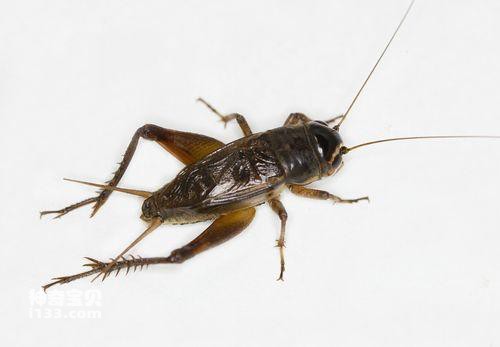Crickets are insects of the family Gryllidae, suborder Ensifera, order Orthoptera, and are a type of insect widely distributed around the world. Crickets are generally smaller in size, and they are known for their characteristic ability to "sing," a behavior in which male crickets rub their forewings to attract females.

Appearance: Crickets have long antennae that exhibit distinct segmentation. Compared to their close relatives, grasshoppers, crickets' antennae are generally longer, sometimes even longer than their bodies. For example, the spotted-winged cricket (the common house cricket).
Body structure: The body of a cricket can be divided into three parts: head, thorax and abdomen. The thorax has three pairs of legs and two pairs of wings. The forewings are well developed and are often used to make chirping sounds, while the hind wings are flat and used for flying.
Sound production: Male crickets produce sounds by rubbing two special parts of their forewings (the file and the chirping area), a behavior called "chirping."
Diet: Crickets are omnivores and their diet includes plants, fruits, seeds, insects, and even other dead insects.
Nocturnal: Crickets are active at night and usually hide in dark places during the day, such as under rocks, in wood, and at the roots of plants.
Environmental Adaptations: They can survive in a variety of environments, including grasslands, trees, caves and even alpine terrain.
Chirping: Different species of crickets have unique chirping patterns and purposes, including to attract a mate, to claim territory, or to warn other crickets.
Mating: Chirping is the main way male crickets attract females. After mating, the female cricket lays eggs in soft soil.
Development: Cricket larvae look similar to adults, but are smaller in size and lack fully developed wings. They slowly grow into adults through multiple molts.
Crickets are not generally considered an endangered species, and they are abundant and widely distributed. However, under certain circumstances, overuse of pesticides and habitat destruction may result in the decline of endemic cricket populations.
Cultural Significance: In many cultures, crickets are considered a symbol of good luck and often appear in literature and art.
Edible and Medicinal Uses: In some cultures, crickets are used as food and as traditional medicine.
Pets: Historically, especially in China, keeping crickets as pets or for cricket fighting was a recreational activity.
In the field of biology, crickets are also used as an important model organism for behavioral and ecological research, especially in studies of vocal communication. Therefore, understanding these small insects and their interactions with the natural environment not only enriches human understanding of the natural world, but also promotes the development of science.
animal tags: cricket
We created this article in conjunction with AI technology, then made sure it was fact-checked and edited by a Animals Top editor.